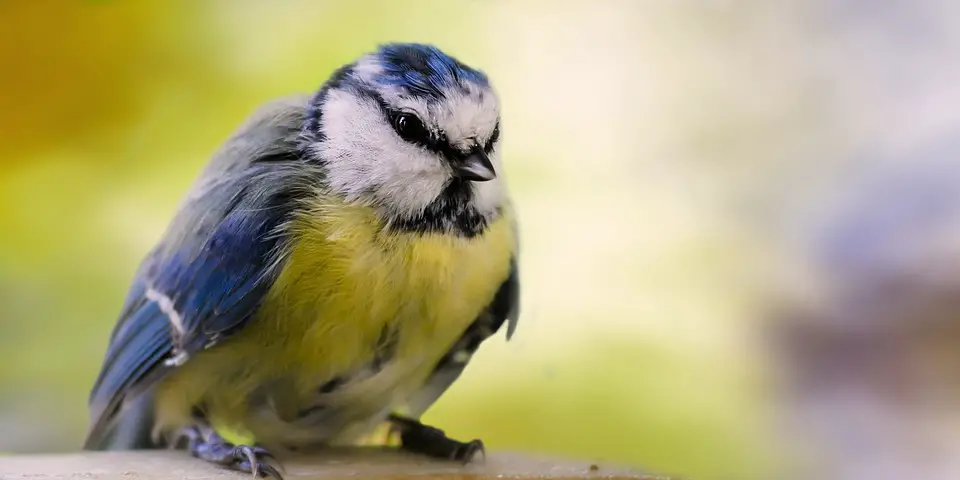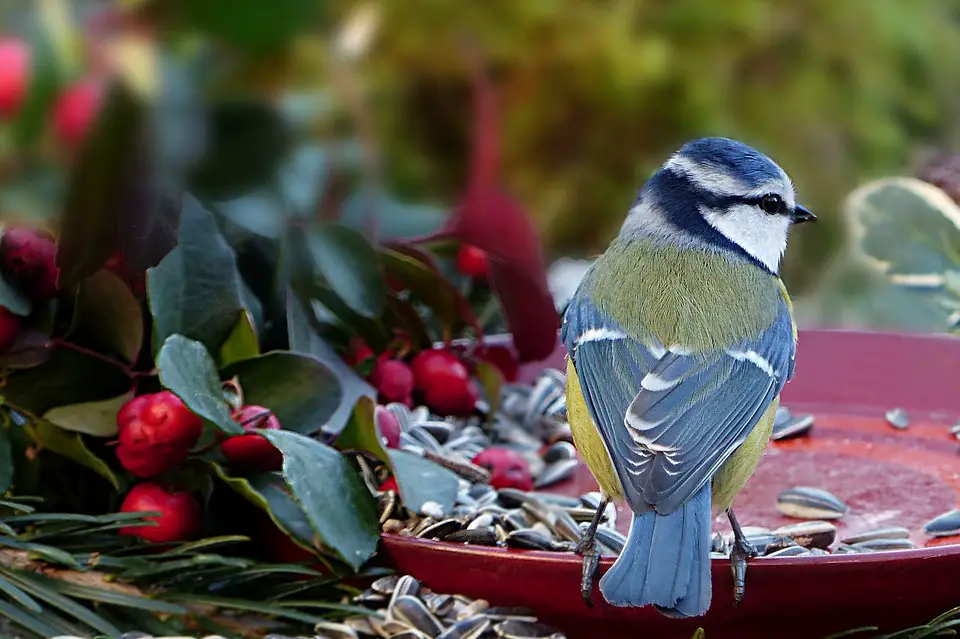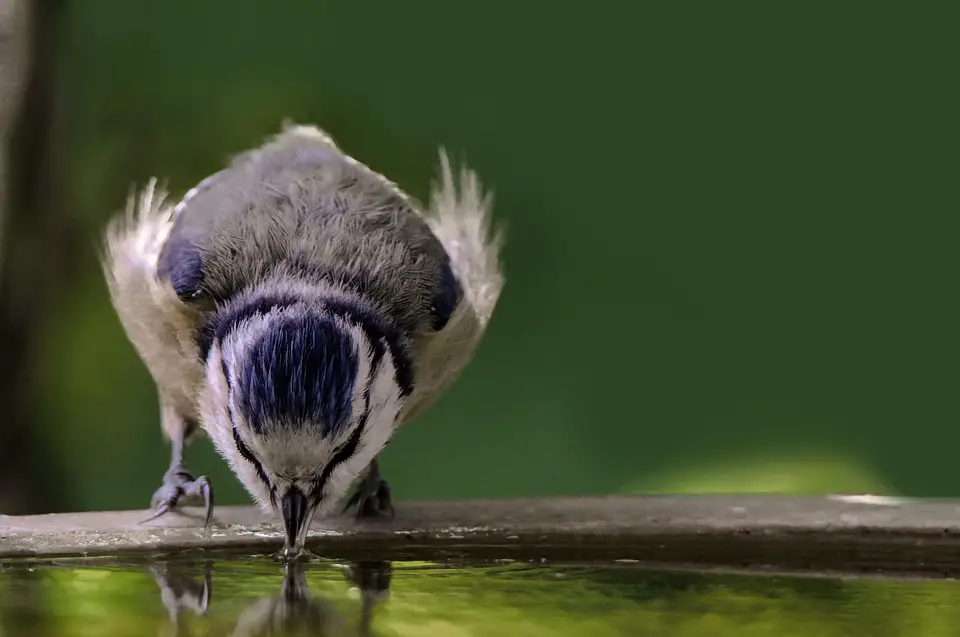Imagine my delight when I discovered a pair of blue tits had chosen my homemade bird box in which to start their family.
I would head into the garden armed with a mug of tea and just sit quietly and watch this beautiful and serene sight in total awe.
The adult birds busying themselves collecting things to line the box and then, once the chicks had hatched, making several return journeys with food.

Sadly, this was a few years ago and has not been repeated since. Although I get infrequent visits to the feeding table, I am very keen to find out how to make them long term guests again.
Table of Contents
Blue Tits love Peanuts
When trying to attract wild birds to your garden the main criteria are always the same. Making sure there is a plentiful supply of their favourite food and a safe environment in which they can rest and hopefully nest, are always top the list.
Peanuts. That’s it! They are their absolute favourite treat. Crush them and hang in a feeder then sit back to watch his aerial acrobatics as he makes many return journeys.
The blue tit will find other things available at your bird station tempting too. Sunflower seeds, suet and mealworms are tasty delights for him. He will also nibble on tube feeders on mixed seed.
Blue tits are cavity nesters, so any garden that has premade small holes and cavities appeal to them. Cracks and gaps in tree trunks and boughs are ideal. Similarly, bird boxes with small entrance holes, hung high in trees away from threats from predators, will attract them.
Omnivores!
They are omnivorous birds; they eat plant and animal life although insects more during breeding season. A plentiful supply of both ensures return visits.
When blue tits aren’t hunting for food they are perching in trees, singing and chattering, so a garden with lots of trees and shrubs is desirable, they are also home to many of the bugs and insects on which the birds feed.
Well planted areas with lots of available cover where the blue tit doesn’t feel exposed or threatened are vital. He also needs good visibility, to spot any incoming threat or for a clean run to the feeding area!

Feeding Time
Blue tits are acrobatic birds that succeed using the majority of different types of feeder available on the market. It’s not unusual to see him hanging from a tube feeder, eating suet from a coconut shell or dangling from a string of monkey nuts!
Peanuts are the absolute must when trying to attract blue tits to your garden. Not only do they find them delicious, they are power packed with oil and proteins. Protein is necessary to provide them with much needed energy to get through long cold winter nights.
Crushed peanuts are simple for the bird to eat and digest and are an absolute must during breeding season. The more naïve blue tit might be tempted to feed its young with a whole nut and this is obviously a choking hazard.
If you use whole peanuts, never use salted or dry roasted, the risk of causing illness to the bird, or even death is great.
Hang the nuts in a mesh tubing feed with small ports of around 6mm, that way the blue tit will just nibble tiny pieces.
This will appeal to all members of the tit family, blackbirds, chaffinches, sparrows and even robins too.
Plants & Insects
You will find that blue tits will be tempted by many other things on your bird table, sunflower seeds and hearts, suet blocks, fat balls and even mixed seed will entice him. They enjoy swinging from a filled coconut shell too. Mealworms are a great source of nutrition for them to enjoy.
They will eat bugs occasionally but never more so than early spring when they feed them to their young; insects, caterpillars, spiders and larvae. The adults indulge too.
Planting bushes laden with bright berries will attract the insects, and in turn, the blue tit too.
Rose bushes and clematis will definitely catch the blue tit’s attention; they forage through the leaves and hoover up the aphids to feed their nestlings.
The bird can be a friend to the keen vegetable grower too; caterpillars crawling in your vegetable patch are a protein packed lunch for blue tits!
Always have water available for the birds to not only drink but bathe in, fresh rainwater collected from your water butt is ideal.

Room with a View
If you’re lucky enough to have trees in your garden, then you’re halfway there to attracting blue tits.
Consider hanging a bird box with a very small entrance hole, early in the year. The blue tit will have done several reconnaissance missions over the weeks to ensure it’s ideal for his brood to be raised, and also to check that some other bird hasn’t inhabited it, the cheek! Once he has moved in, he will line it with wool, feathers and moss.
Same time next year?
If you have successfully had a family of blue tits in your nesting box, and would like to encourage more, wait until at least August to be positive that the family has flown. Take the box down whilst wearing gloves, empty the remainders of the nest and wash it out with a solution of one part bleach to nine parts water. Rinse and then leave it to thoroughly dry before rehanging it.
This should ensure they show an interest in hatching their young inside your bird box year after year.
Blue tits are more likely to visit your garden if they feel there is little threat, consider planting a thorny bush beneath the table to foil any cats, hang food higher in trees and near to well-planted areas.
They love swooping from tree to shrub, a friend of mine has noted that they love all varieties of tree in his garden and have shown a particular fondness for the silver birch, he has several pairs daily chattering away on there as it’s a haven for grubs and insects. When it’s in flower, the blue tits enjoy the soft buds too.
The birds will head for any large annual or perennial plants, particularly those with tall stems. They offer cover that doesn’t leave them exposed to threat and some have the added benefit of easily accessible seeds.
Competition?
Have a family contest to grow the tallest sunflower, very rewarding to watch a blue tit pilfering the seeds from the tallest one!
It would seem that if your garden is well planted and you are lucky enough to have trees lock the cat in the house and hang a tube of crushed peanuts from a branch and within seconds, you could be having a blue tit party!
Hanging a bird box in the tree means they may stay until early summer!
I wonder if we could charge board and lodgings?!

This was a really helpful and informative read -answered all my questions
Thank you
Hello 🙂
We have a little blue tit tentatively inspecting our busy bird feeders and I so want to encourage him to stay awhile and feed. So, I shall use my one (currently permitted) walk a day to my local pet store and purchase some peanuts and a suitable feeder in the hopes he will become a frequent visitor. Thank you Walter for your insightful website. It’s been a lovely distraction during these strange times to discover my new found love of garden birds and your hints and tips are certainly helpful.
Our feeder is filled with sunflower hearts. The blue tits take a seed, fly up to a branch in our apple tree – work on it in some way – rapid side to side head movement rubbing on the branch. Are they cleaning their beaks or doing something to the seed. They then fly back down to the feeder and repeat. We get a lot of green finches and gold finches and they don’t seem to do this – any idea what this behaviour is about?
I am not sure! They may be trying to help break it down before swallowing it?
I have Put some blue tit house up late last yr on the garage wall so hopefully I will attract some my garden.the garden is paved as I have a dog that take no interest in the birds a less is is a pigeon. I have a pear tree and a small at the moment plum tree in a pot with feeders on two of my wall was thinking of hanging a feeder under the bird houses like a mixed seed and a peanut one any help
Thanks